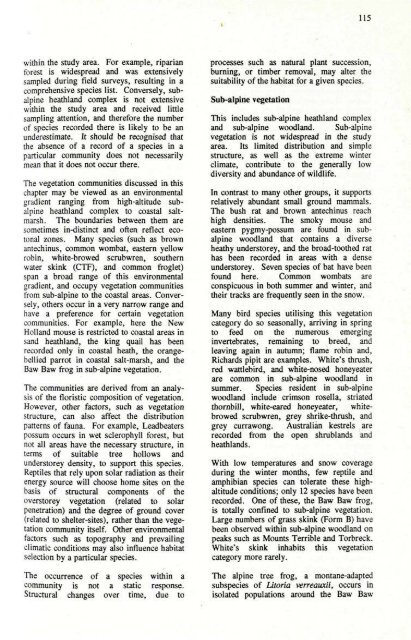Factors Affecting Flora Conservation - Victorian Environmental ...
Factors Affecting Flora Conservation - Victorian Environmental ...
Factors Affecting Flora Conservation - Victorian Environmental ...
You also want an ePaper? Increase the reach of your titles
YUMPU automatically turns print PDFs into web optimized ePapers that Google loves.
115<br />
widiin the study area. For example, riparian<br />
forest is widespread and was extensively<br />
sampled during field surveys, resulting in a<br />
comprehensive species list. Conversely, subalpine<br />
heathland complex is not extensive<br />
within the study area and received little<br />
sampling attention, and therefore the number<br />
of species recorded there is likely to be an<br />
underestimate. It should be recognised that<br />
the absence of a record of a species in a<br />
particular community does not necessarily<br />
mean that it does not occur there.<br />
The vegetation communities discussed in this<br />
chapter may be viewed as an environmental<br />
gradient ranging from high-altitude subalpine<br />
heathland complex to coastal saltmarsh.<br />
The boundaries between them are<br />
sometimes in-distinct and often reflect ecotonal<br />
zones. Many species (such as brown<br />
antechinus, common wombat, eastern yellow<br />
robin, white-browed scmbwren, southern<br />
water skink (CTF), and common froglet)<br />
span a broad range of this environmental<br />
gradient, and occupy vegetation communities<br />
from sub-alpine to the coastal areas. Conversely,<br />
others occur in a very narrow range and<br />
have a preference for certain vegetation<br />
communities. For example, here the New<br />
Holland mouse is restricted to coastal areas in<br />
sand heathland, the king quail has been<br />
recorded only in coastal heath, the orangebellied<br />
parrot in coastal salt-marsh, and the<br />
Baw Baw frog in sub-alpine vegetation.<br />
The communities are derived from an analysis<br />
of the floristic composition of vegetation.<br />
However, other factors, such as vegetation<br />
stmcture, can also aftect the distribution<br />
patterns of fauna. For example, Leadbeaters<br />
possum occurs in wet sclerophyll forest, but<br />
not all areas have the necessary stmcture, in<br />
terms of suitable tree hollows and<br />
understorey density, to support this species.<br />
Reptiles that rely upon solar radiation as their<br />
energy source will ch(X)se home sites on the<br />
basis of stmctural components of the<br />
overstorey vegetation (related to solar<br />
penetration) and the degree of ground cover<br />
(related to shelter-sites), rather than the vegetation<br />
community itself. Other environmental<br />
factors such as topography and prevailing<br />
climatic conditions may also influence habitat<br />
selection by a particular species.<br />
The occurtence of a species within a<br />
community is not a static response.<br />
Stmctural changes over time, due to<br />
processes such as natural plant succession,<br />
burning, or timber removal, may alter the<br />
suitabUity ofthe habitat for a given species.<br />
Sub-alpine vegetation<br />
This includes sub-alpine heathland complex<br />
and sub-alpine woodland. Sub-alpine<br />
vegetation is not widespread in the study<br />
area. Its limited distribution and simple<br />
stmcture, as well as the exfreme winter<br />
climate, contribute to the generally low<br />
diversity and abundance of wildlife.<br />
i<br />
In confrast to many other groups, it supports<br />
relatively abundant small ground mammals.<br />
The bush rat and brown antechinus reach<br />
high densities. The smoky mouse and<br />
eastern pygmy-possum are found in subalpine<br />
woodland that contains a diverse<br />
heathy understorey, and the broad-toodied rat<br />
has been recorded in areas with a dense<br />
understorey. Seven species of bat have been<br />
found here. Common wombats are<br />
conspicuous in both summer and winter, and<br />
their fracks are frequently seen in the snow.<br />
Many bird species utUising this vegetation<br />
category do so seasonally, arriving in spring<br />
to feed on the numerous emerging<br />
invertebrates, remaining to breed, and<br />
leaving again in autumn; flame robin and,<br />
Richards pipit are examples. White's thmsh,<br />
red wattlebird, and white-nosed honeyeater<br />
are common in sub-alpine woodland in<br />
summer. Species resident in sub-alpine<br />
woodland include crimson rosella, striated<br />
thornbill, white-eared honeyeater, whitebrowed<br />
scmbwren, grey shrike-thmsh, and<br />
grey currawong. Ausfralian kesfrels are<br />
recorded from the open shmblands and<br />
heathlands.<br />
With low temperatures and snow coverage<br />
during the winter months, few repfile and<br />
amphibian species can tolerate these highaltitude<br />
conditions; only 12 species have been<br />
recorded. One of diese, die Baw Baw frog,<br />
is totally confined to sub-alpine vegetation.<br />
Large numbers of grass skink (Form B) have<br />
been observed within sub-alpine woodland on<br />
peaks such as Mounts Tertible and Torbreck.<br />
White's skink inhabits this vegetation<br />
category more rarely.<br />
The alpine free frog, a montane-adapted<br />
subspecies of Litoria verreauxii, occurs in<br />
isolated populations around the Baw Baw
















